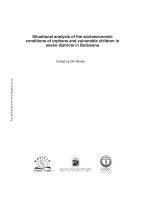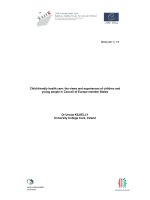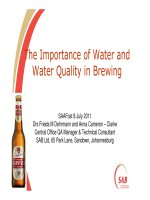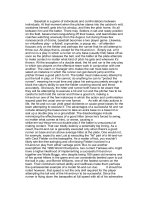molecular dynamics simulation of thermal and thermomechanical phenomena in picosecond laser material interaction
Bạn đang xem bản rút gọn của tài liệu. Xem và tải ngay bản đầy đủ của tài liệu tại đây (579.51 KB, 9 trang )
Molecular dynamics simulation of thermal and
thermomechanical phenomena in picosecond laser
material interaction
Xinwei Wang
a,
*
, Xianfan Xu
b
a
Department of Mechanical Engineering, N104 Walter Scott Engineering Center, The University of Nebraska at Lincoln,
Lincoln, NE 68588-0656, USA
b
School of Mechanical Engineering, Purdue University, West Lafayette, IN 47907, USA
Received 2 November 2001; received in revised form 30 June 2002
Abstract
In recent years, short pulsed laser materials interaction has attracted considerable attention owing to the rapid
development of short pulsed lasers and their potential applications in laser-material processing. In this work, molecular
dynamics (MD) simulations are conducted to study the thermal and thermomechanical phenomena induced by pico-
second laser heating. The generation and propagation of the stress wave are calculated and depicted in detail. Results of
the MD simulation are compared with those obtained with an analytical solution. In addition, a temperature wave as a
result of the coupling between temperature and the strain rate is observed, which propagates at the same speed as the
stress wave.
Ó 2002 Elsevier Science Ltd. All rights reserved.
1. Introduction
Thermal and thermomechanical phenomena in ul-
trafast laser materials interaction are of great impor-
tance for ultrafast laser processing and non-destructive
detection. In recent years, a large amount of work has
been conducted in this area. Due to the extremely short
laser heating duration and the resulting rapid heating
and stress development, there are many difficulties to
experimentally investigate the thermomechanical waves
inside the material. For analytical studies, the contin-
uum approach to solving heat transfer problems and
thermal–mechanical coupling can be questionable in
these extreme situations. The molecular dynamics (MD)
simulation, which solves the movement of atoms or
molecules directly, is capable of revealing the mecha-
nism behind the thermal and thermomechanical phe-
nomena in ultrafast laser materials interaction.
In the past several years, many MD simulations of
laser materials interaction were reported. Most work
was restricted to systems consisting of a small number of
atoms. Qualitative results such as the structural change
of the target due to laser heating were obtained but few
macro-scale phenomena were studied. For instance,
H
€
aakkinen and Landman [1] studied the dynamics of
phase change in a copper subjected to surface laser
heating. Their work provided significant insights per-
taining to dynamics, energetics, and structure of surface
superheating and melting processes. Other examples
include work by Kluge and Ray [2], Chokappa et al. [3],
Shibahara and Kotake [4,5], Silvestrelli and Parrinello
[6], and Jeschke et al. [7], in which changes of the
structure of small systems subjected to ultrafast laser
heating were studied. The absorption of laser energy was
simulated by exciting the potential energy of atoms [8,9],
adding extra energy to the kinetic energy of atoms
[10,11], or exciting the vibration of molecules [12–14].
Laser induced thermomechanical waves were studied in
a metal [15] by using the Morse potential function [16],
in an organic solid using the breathing sphere model
[17], and in an argon solid [11].
International Journal of Heat and Mass Transfer 46 (2003) 45–53
www.elsevier.com/locate/ijhmt
*
Corresponding author. Tel.: +1-402-472-3089; fax: +1-402-
472-1465.
E-mail address: (X. Wang).
0017-9310/03/$ - see front matter Ó 2002 Elsevier Science Ltd. All rights reserved.
PII: S 0 017-9 310( 0 2 )002 5 9-4
In this work, MD simulations are conducted to study
the thermal and thermomechanical phenomena in laser
argon interaction using the laser absorption model in
which laser energy is added to the kinetic energy of
atoms. Various systems are investigated which consist of
up to 1,944,000 atoms, which is a suitable number to be
handled by the authors’ computer resource in terms of
suppressing the statistical uncertainty and revealing
macro-scale phenomena in laser ablation. This work
emphasizes the evolution and propagation of tempera-
ture and thermomechanical waves during and after laser
heating. For the first time, the thermal–mechanical
coupling is studied in detail, which has a strong impact
on the temperature distribution and explains the
noticeable temperature drop in the near surface region.
A temperature wave different from that induced by the
non-Fourier effect is observed propagating at the same
speed as the stress wave. In Section 2, theories of the
MD simulation used in this work are introduced. The
simulation results are summarized in Section 3.
2. Simulation methods
In this work, an argon crystal at an initial tempera-
ture of 50 K illuminated by a picosecond (ps) laser pulse
is studied. The basic problem involved is to solve the
Newtonian equations for each atom interacting with its
neighbors,
m
i
d
2
r
i
dt
2
¼
X
j6¼i
F
ij
ð1Þ
where m
i
and r
i
stand for the mass and position of atom
i, respectively. F
ij
is the interaction force between atoms i
and j, which is calculated from the Lennard–Jones (LJ)
potential as F
ij
¼Ào/
ij
=or
ij
. The LJ potential /
ij
is
written as
/
ij
¼ 4e
r
e
r
ij
12
"
À
r
e
r
ij
6
#
ð2Þ
where e is the LJ well depth parameter, r
e
is the equi-
librium separation parameter, and r
ij
¼ r
i
À r
j
.
In the calculation, the half-step leap-frog scheme––a
modification to the velocity Verlet algorithm [18], is
employed to solve the movement of atoms. When the
distance between particles is larger than a certain dis-
tance r
c
, namely the cutoff distance, the interaction be-
tween them is negligible, and no interaction calculation
is necessary. The interaction computation of an atom
with its neighbors is organized by the cell structure and
the linked list methods [18]. In these methods, the
computational domain is divided to small cells with a
characteristic size of r
c
, and each atom is sorted into a
certain cell based on its position. Only the interaction
between atoms in adjacent cells is considered.
The laser beam absorption in the target is simulated
by exciting the kinetic energy of atoms, and is fulfilled by
scaling the velocities of all atoms in each cell by an ap-
propriate factor. The laser beam is assumed to be ab-
sorbed exponentially with an optical absorption depth s,
dI
dz
¼ÀIðzÞ=s ð3Þ
This laser energy absorption model de-emphasizes
the details of laser materials interaction, in which the
quantum mechanical effect needs to be accounted for.
However, the time scale for the process of laser energy
absorption (<1 ps) is much smaller than the time scale
Nomenclature
B bulk modulus
c
p
specific heat
F force
G shear modulus
I laser beam intensity
k thermal conductivity
k
B
Boltzmann’s constant
m mass of an atom
r position of an atom
r
c
cutoff distance
r
s
the nearest neighbor distance
t time
T temperature
T
0
initial temperature
dt time step
DT temperature elevation
u displacement
v velocity
Greek symbols
a thermal diffusivity
b
T
thermal expansion coefficient
e LJ well depth parameter
/ Lennard–Jones potential
q density
r stress
r
e
equilibrium separation parameter
s optical absorption depth
s
q
thermal relaxation time
Subscript
i index of the atom
46 X. Wang, X. Xu / International Journal of Heat and Mass Transfer 46 (2003) 45–53
considered in this work. Therefore, without knowing the
details of the laser materials interaction, the thermal and
thermomechanical effect can still be investigated using
the current absorption model. In this work, s is chosen
to be 2.5 nm to account for the effect of volumetric
absorption of the laser beam. The laser pulse is assumed
to have a temporal Gaussian distribution with a full
width at half maximum (FWHM) of 5 ps centered at 10
ps.
The schematic of the computational domain is shown
in Fig. 1. Extra spaces are added above and below the
target, which allow the macro-motion of atoms in the z
direction. Periodic boundary conditions are imple-
mented on boundaries in the x and y directions, and free
boundary conditions on boundaries in the z direction.
The first step of the calculation is to initialize the system
to thermal equilibrium before laser heating starts, which
is achieved by a thermal equilibrium calculation. In this
calculation, the target is initially constructed based on
the fcc lattice structure with the (1 0 0) surface facing the
laser beam. The nearest neighbor distance, r
s
, in the fcc
lattice of argon depends on temperature T, and is cal-
culated using the expression given by Broughton and
Gilmer [19],
r
s
r
e
¼ 1:0964 þ 0:054792
k
B
T
e
þ 0:014743
k
B
T
e
2
þ 0:083484
k
B
T
e
3
À 0:23653
k
B
T
e
4
þ 0:25057
k
B
T
e
5
ð4Þ
The initial velocities of atoms are specified randomly
from a Gaussian distribution based on the specified
temperature of 50 K using the following formula
1
2
m
X
3
i¼1
v
2
i
¼
3
2
k
B
T ð5Þ
Before laser heating starts, the sample is thermalized
for 100 ps to reach thermal equilibrium. The values of the
parameters used in the simulation are listed in Table 1.
The MD simulation results are compared with the
analytical solutions to the following equations [20]:
s
q
a
o
2
T
ot
2
þ
1
a
oT
ot
¼
o
2
T
oz
2
þ
1
ks
ðI þ s
q
_
IIÞe
Àz=s
À
Bb
T
T
0
k
o
2
u
ozot
þ s
q
o
3
u
ozot
2
ð6Þ
q
o
2
u
ot
2
¼ B
þ
4
3
G
o
2
u
oz
2
À Bb
T
oT
oz
ð7Þ
In the foregoing equations, a is the thermal diffusivity, k
is the thermal conductivity, q is the density, B and G are
the bulk and shear moduli of elasticity, b
T
is the volu-
metric thermal expansion coefficient, and T
0
is the initial
temperature of the target. s
q
is the thermal relaxation
time, which is introduced to account for the non-Fourier
effect in ultrafast laser heating [21]. Details of the ana-
lytical solutions are described elsewhere [20]. The
properties of argon are treated as constants. It is esti-
mated that the average temperature of the argon solid in
the near surface region is around 60 K for the fluence of
0.12 J/m
2
. Therefore, the properties of argon at 60 K are
used, and are listed in Table 2 [22,23]. The thermal
conductivity and specific heat have been adjusted based
on the MD simulation results [24].
3. Results and discussions
In this work, the thermal and thermomechanial
waves induced by ps laser heating as well as the thermal–
mechanical coupling are emphasized. Ablation and the
Fig. 1. Schematic of the computational domain for MD sim-
ulations.
Table 1
The values of the parameters used in the simulation
Parameter Value
e, LJ well depth parameter (J) 1:653 Â 10
À21
r
e
, LJ equilibrium separation (
AA) 3.406
m, Argon atomic mass (kg) 66:3 Â 10
À27
k
B
, Boltzmann’s constant (J/K) 1:38 Â 10
À23
a, Lattice constant (
AA) 5.414
r
c
, Cut off distance (
AA) 8.515
s, Laser beam absorption depth (nm) 2.5
dt, Time step (fs) 25
Table 2
The properties of argon used in the calculation
Parameter Value
q, Density (kg/m
3
)1:69 Â 10
3
k, Thermal conductivity (W/m K) 0.247
c
p
, Specific heat (J/kg K) 8:48 Â 10
2
G, Shear modulus (kg/s
2
m) 8:03 Â 10
8
B, Bulk modulus (kg/s
2
m) 2:17 Â 10
9
b
T
, Volumetric thermal expansion coeffi-
cient (1/K)
1:45 Â 10
À3
s
q
, Thermal relaxation time (s) 5:13 Â 10
À13
X. Wang, X. Xu / International Journal of Heat and Mass Transfer 46 (2003) 45–53 47
structural change of the target induced by ps laser
heating are published elsewhere [24].
3.1. Comparison between the MD simulation and the
analytical solution
The thermal and thermomechanical phenomena in-
duced by pulsed laser heating at a laser fluence below the
melting threshold are first presented. An argon sample
with 90 fcc unit cells in both x and y directions and 60
fcc unit cells in the z direction is illuminated by a pulsed
laser with a fluence of 0.12 J/m
2
. The number of the total
atoms under study is 1,944,000. The target measures
48.73 nm in both x and y directions, and 32.48 nm in the
z direction.
Fig. 2 compares the temperature distributions ob-
tained from the MD simulation and the analytical so-
lution. It is seen that the results of the MD simulation
agree well with those of the analytical solution. At 20
and 25 ps, a thermal wave is observed clearly, which is
enlarged in the inset. It needs to be pointed out that this
thermal wave is not the one induced by the non-Fourier
effect. In the present situation, the non-Fourier effect
should have an insignificant effect on heat transfer due
to the relatively small thermal relaxation time ($1 ps).
The thermal wave shown in Fig. 2 originates from
the localized heating due to the coupling between the
temperature and the strain rate. From Eq. (6), it can be
seen that the local temperature change (DT ) due to the
coupling between the temperature and the strain rate
is proportional to the local strain rate, qc
p
oT =ot $
ÀBb
T
T
0
o
2
u=ðozotÞ. Or, the temperature change is related
to stress (r)as
oT =ot $ÀB=ðB þ 4=3GÞb
T
T
0
=ðqc
p
Þor=ot ð8Þ
Fig. 2 also shows some discrepancy between the re-
sults obtained by the MD simulation and the analytical
solution. It is seen that in the near surface region, the
temperature obtained by the MD simulation is a little
higher than that by the analytical solution. In addition,
it is evident that the thermal wave obtained by the MD
simulation has a larger amplitude and a time delay in
comparison with that by the analytical solution. Rea-
sons for these discrepancies will be discussed later.
The evolution of the displacement obtained by the
MD simulation and the analytical solution is shown in
Fig. 3. It is seen from Fig. 3 that the MD simulation and
Fig. 2. Temperature distribution in the target. ()MD
simulation; (––) analytical solution.
Fig. 3. Evolution of the displacement in the target. ()MD
simulation; (––) analytical solution.
48 X. Wang, X. Xu / International Journal of Heat and Mass Transfer 46 (2003) 45–53
the analytical solution predict the same trend of dis-
placement. At 25 ps, a displacement wave is formed,
which is marked with a circle. The stress induced by
laser heating is displayed in Fig. 4. In the MD simula-
tion, the stress on an interested cross-sectional area is
calculated by adding all the force between each pair of
atoms located on opposite sides of the cross-section,
then dividing the total force by the area of the cross-
section.
A close look at Figs. 3 and 4 reveals that the dis-
placement and stress predicted by the MD simulation
have a larger magnitude compared with those by the
analytical solution. Constant properties are used in the
analytical solution, which under-predict the displace-
ment and stress as well as the temperature field. In ad-
dition, a time delay is observed for the MD simulation
results relative to those obtained by the analytical so-
lution. This is because in the MD simulation, the laser
energy is directly deposited in the form of kinetic energy,
which does not induce a displacement and stress im-
mediately. It takes time for the kinetic energy to be
transformed to the potential energy, which in turn re-
sults in the displacement and stress. Therefore, the dis-
placement, stress, and the temperature wave induced by
the coupling between the temperature and the strain rate
predicted by the MD simulation appear behind those by
the analytical solution.
3.2. Thermal and thermomechanical waves accompanying
laser ablation
In this study, the target is illuminated by a stronger
pulsed laser of a fluence of 0.7 J/m
2
, which causes ab-
lation. Only the MD simulation is conducted since the
analytical solution is not valid for ablation. Fig. 5 shows
the temperature distribution in a target with 90 fcc unit
cells in both x and y directions, and 15 fcc unit cells in
the z direction. An interesting phenomenon is observed
in Fig. 5 where a local temperature minimum appears at
about 10 nm at 20 and 25 ps, which are marked by ar-
rows. These minimum temperatures are caused by the
thermal waves due to the coupling between the tem-
perature and the strain rate. In order to confirm the
existence of the thermal wave and to observe its prop-
agation in space, a longer target is studied, which has 32
fcc unit cells in both x and y directions, and 320 fcc unit
cells in the z direction. This target consists of 1,310,720
atoms, and measures 17.32 nm in both x and y direc-
tions, and 173.25 nm in the z direction. The temperature
distribution and the stress at different times are shown in
Fig. 6. It is noticed that the minimum temperatures are
recaptured at 20 and 25 ps in the near surface region,
and are marked with arrows. The minimum tempera-
tures appear at the location where the maximum tensile
stress appears. In addition, a local maximum tempera-
ture is observed at the location where the maximum
compressive stress appears. These temperature–stress
pairs again indicate the coupling between the stress and
the thermal wave. Eq. (8) demonstrates that the thermal
wave and the stress wave have opposite signs, which are
confirmed by the results shown in Fig. 6. Using Eq. (8),
it is estimated that that the maximum compressive stress
Fig. 4. Stress distribution in the target. () MD simulation;
(––) analytical solution.
Fig. 5. Temperature distribution in the target.
X. Wang, X. Xu / International Journal of Heat and Mass Transfer 46 (2003) 45–53 49
at 40 ps induces a local temperature elevation of around
2 K. The results of the MD simulation show a temper-
ature elevation of about 3 K indicated in the plot at 40
ps. This discrepancy arises form the inaccuracy of the
material properties used in the analytical solution as
discussed before.
Fig. 7 shows the development of displacement and
stress during laser heating as well as their propagation
and reflection on the back side of the target obtained
from the MD simulation. The stress shows some statis-
tical noises resulting from the MD simulation. The fitted
line shows proper shapes of the stress wave. It is evident
Fig. 6. Temperature and stress distributions in the target. (ÁÁÁ) stress; (––) temperature.
50 X. Wang, X. Xu / International Journal of Heat and Mass Transfer 46 (2003) 45–53
in Fig. 7 that at 15 ps, a tensile stress emerges in the near
surface region. The displacement at the surface is posi-
tive (towards outside) due to thermal expansion, while in
the region close to the surface, a negative displacement
occurs due to compression (shown in plots at 15 and 20
ps). At 40 ps, the displacement and stress waves are fully
developed.
The displacement and stress waves are reflected when
they reach the back side of the target. This reflecting
process is demonstrated in the plots from 140 to 165 ps.
Fig. 7. Development of the displacement and stress in the target. (– – –) displacement; (ÁÁÁ) stress; (––) fitted curve of the stress to guide
the eye.
X. Wang, X. Xu / International Journal of Heat and Mass Transfer 46 (2003) 45–53 51
At 145 ps, the front of the stress wave, which is com-
pressive, reaches the back side of the target and is re-
flected. After reflection, the compressive stress becomes
tensile. At 150 ps, this tensile stress combines with the
tensile stress of the original stress wave, forming a
stronger tensile stress wave. At 160 ps, the tensile stress
from reflection and the tensile stress of the original stress
wave separate. The tensile stress of the original stress is
reflected and becomes compressive, which is shown in
the plot at 165 ps. The original stress wave is completely
reversed after reflection. Based on the locations of the
peak compressive stress at different times, the speed of
the stress wave along the [1 0 0] direction is calculated to
be 1333 m/s. This value agrees well with the experi-
mental sound speed (1425 m/s) of argon in the [1 0 0]
direction [22].
4. Conclusion
In this work, MD simulations were performed to
study the thermal and thermomechanical waves in ps
laser interaction with solid argon. The MD simulation
results were compared with the results of the analytical
solution at a laser fluence below the melting threshold. It
was concluded that without phase change, the temper-
ature field predicted by the MD simulation agreed with
that by the analytical solution. Discrepancy between the
MD simulation and the analytical solutions is caused by
the constant properties used in the analytical solution.
Temperature waves were observed and successfully ex-
plained by the coupling between the temperature and the
strain rate. It was also demonstrated that the MD sim-
ulation is capable of capturing the details of the devel-
opment, propagation, and reflection of stress and
displacement waves during and after laser heating.
Acknowledgements
Support for this work by the National Science
Foundation (CTS-9624890) is gratefully acknowledged.
X. Wang is also grateful for the financial support of the
start-up fund from the College of Engineering and
Technology and the Department of Mechanical Engi-
neering at the University of Nebraska at Lincoln.
References
[1] H. H
€
aakkinen, U. Landman, Superheating, melting, and
annealing of copper surfaces, Phys. Rev. Lett. 71 (1993)
1023–1026.
[2] M.D. Kluge, J.R. Ray, Pulsed laser melting of silicon: A
molecular dynamics study, J. Chem. Phys. 87 (1987) 2336–
2339.
[3] D.K. Chokappa, S.J. Cook, P. Clancy, Nonequilibrium
simulation method for the study of directed thermal pro-
cessing, Phys. Rev. B 39 (1989) 10075–10087.
[4] M. Shibahara, S. Kotake, Quantum molecular dynamics
study on light-to-heat absorption mechanism: Two metallic
atom system, Int. J. Heat Mass Transfer 40 (1997) 3209–
3222.
[5] M. Shibahara, S. Kotake, Quantum molecular dynamics
study of light-to-heat absorption mechanism in atomic
systems, Int. J. Heat Mass Transfer 41 (1998) 839–849.
[6] P.L. Silvestrelli, M. Parrinello, Ab initio molecular dy-
namics simulation of laser melting of graphite, J. Appl.
Phys. 83 (1998) 2478–2483.
[7] H.O. Jeschke, M.E. Garcia, K.H. Bennemann, Theory for
laser-induced ultrafast phase transitions in carbon, Appl.
Phys. A 69 (1999) S49–S53.
[8] S. Kotake, M. Kuroki, Molecular dynamics study of solid
melting and vaporization by laser irradiation, Int. J. Heat
Mass Transfer 36 (1993) 2061–2067.
[9] R.F.W. Herrmann, J. Gerlach, E.E.B. Campbell, Ultra-
short pulse laser ablation of silicon: An MD simulation
study, Appl. Phys. A 66 (1998) 35–42.
[10] E. Ohmura, I. Fukumoto, I. Miyamoto, Modified molec-
ular dynamics simulation on ultrafast laser ablation of
metal, in: The International Congress on Applications of
Lasers and Electro-Optics, Laser Institute of America,
Orlando, 1999, pp. 219–228.
[11] J.I. Etcheverry, M. Mesaros, Molecular dynamics simula-
tion of the production of acoustic waves by pulsed laser
irradiation, Phys. Rev. B 60 (1999) 9430–9434.
[12] L.V. Zhigilei, P.B.S. Kodali, B.J. Garrison, Molecular
dynamics model for laser ablation and desorption of
organic solids, J. Phys. Chem. B 101 (1997) 2028–2037.
[13] L.V. Zhigilei, B.J. Garrison, Computer simulation study of
damage and ablation of submicron particles from short-
pulse laser irradiation, Appl. Surf. Sci. 127–129 (1998) 142–
150.
[14] L.V. Zhigilei, P.B.S. Kodali, B.J. Garrison, A microscopic
view of laser ablation, J. Phys. Chem. B 102 (1998) 2845–
2853.
[15] E. Ohmura, I. Fukumoto, Molecular dynamics simulation
on laser ablation of FCC metal, Int. J. Jpn Soc. Precision
Eng. 30 (1996) 128–133.
[16] L.A. Girifalco, V.G. Weizer, Application of the morse
potential function to cubic metals, Phys. Rev. 114 (1959)
687–690.
[17] L.V. Zhigilei, B.J. Garrison, Pressure waves in microscopic
simulations of laser ablation, Mater. Res. Soc. Symp. Proc.
538 (1999) 491–496.
[18] M.P. Allen, D.J. Tildesley, Computer Simulation of
Liquids, Clarendon Press, Oxford, 1987 (Chapter 3 and 5).
[19] J.Q. Broughton, G.H. Gilmer, Molecular dynamics inves-
tigation of the crystal–fluid interface. I. Bulk properties, J.
Chem. Phys. 79 (1983) 5095–5104.
[20] X. Wang, X. Xu, Thermoelastic wave induced by pulsed
laser heating, Appl. Phys. A 73 (2001) 107–144.
[21] D.Y. Tzou, Macro- to Microscale Heat Transfer––The
Lagging Behavior, Taylor and Francis, Washington, 1996.
[22] G.J. Keeler, D.N. Batchelder, Measurement of the elastic
constants of argon from 3 to 77 K, J. Phys. C: Solid State
Phys. 3 (1970) 510–522.
52 X. Wang, X. Xu / International Journal of Heat and Mass Transfer 46 (2003) 45–53
[23] O.G. Peterson, D.N. Batchelder, R.O. Simmons, Measure-
ments of X-ray lattice constant, thermal expansivity, and
isothermal compressibility of argon crystals, Phys. Rev.
150 (1996) 703–711.
[24] X. Wang, X. Xu, Molecular Dynamics Simulation of Heat
Transfer and Phase Change during Laser Material Inter-
action, Proceedings of the 35th National Heat Transfer
Conference, ASME, 2001, paper# NHTC 2001-20070.
X. Wang, X. Xu / International Journal of Heat and Mass Transfer 46 (2003) 45–53 53









